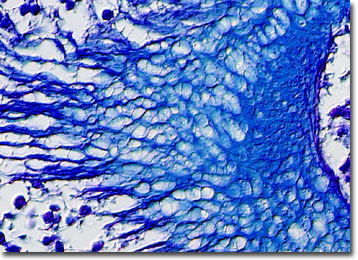Differential Interference Contrast Image Gallery
Portuguese Man-of-War Tentacles
The Portuguese man-of-war, known as the bluebottle in Australia, has a jelly-like appearance, but is not a jellyfish. In fact, the organism is not even a single entity.

A colony of polyps that live interdependently make up the “animal” known as the Portuguese man-of-war. Its “body” is a translucent, gas-filled float called a pneumatophore. Attached to the float is a crest that acts like a sail and moves the organism through the water. Underneath the float are three different types of polyps: dactylozooid, gonozooid, and gastrozooid. Each kind of polyp carries out specific functions and contributes to the survival of the colony.
The dreaded tentacles of the Portuguese man-of-war belong to the dactylozooid polyps it contains. Their stinging nematocysts can paralyze small prey and cause immense pain to humans, which is sometimes accompanied by powerful allergic reactions that lead to fever and shock, as well as heart and lung problems. In fact, the toxin exuded by the tentacles of the Portuguese man-of-war is about 75 percent as powerful as the venom of a cobra. Even when they are washed up on the beach, the tentacles remain dangerous and should not be touched with bare skin.
Some animals, however, do not appear to be adversely affected by the tentacles of the Portuguese man-of-war. The loggerhead turtle, for instance, frequently eats the marine organisms. Also, a small fish scientifically described as Nomeus gronovii lives comfortably among the tentacles, using them as protective cover from predators and occasionally feeding upon them. Since they are constantly regenerated, the tentacles provide an interminable food source to any species that can safely ingest them.
